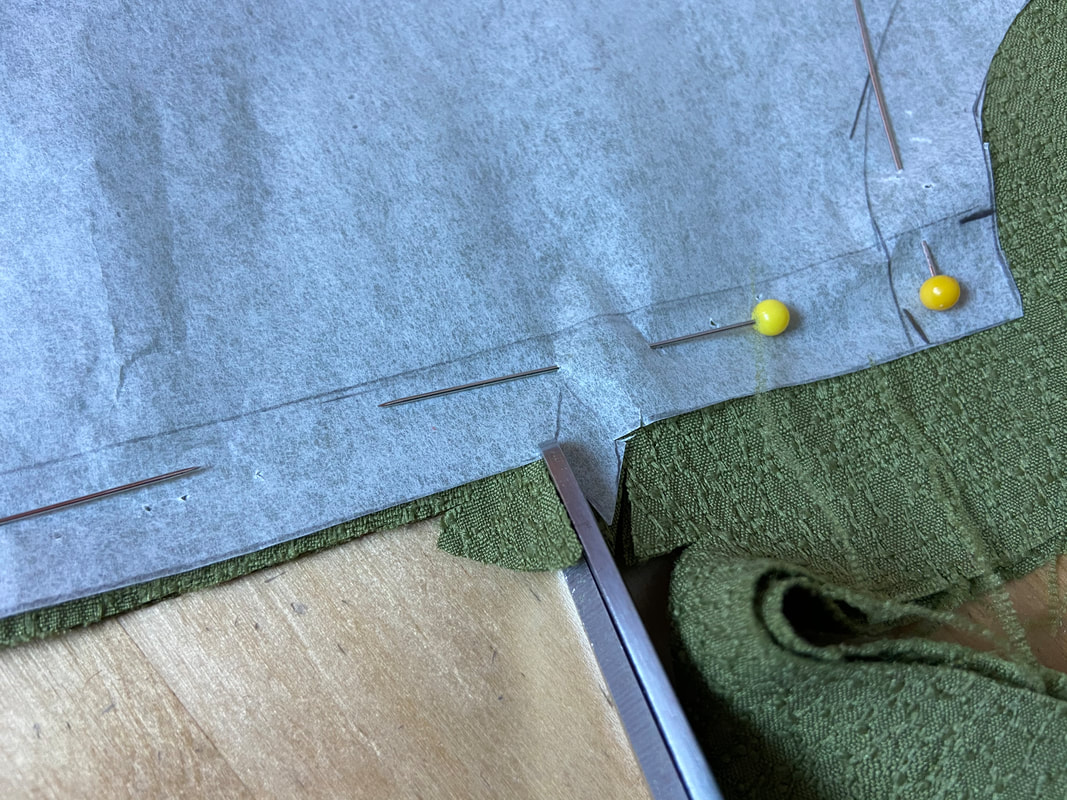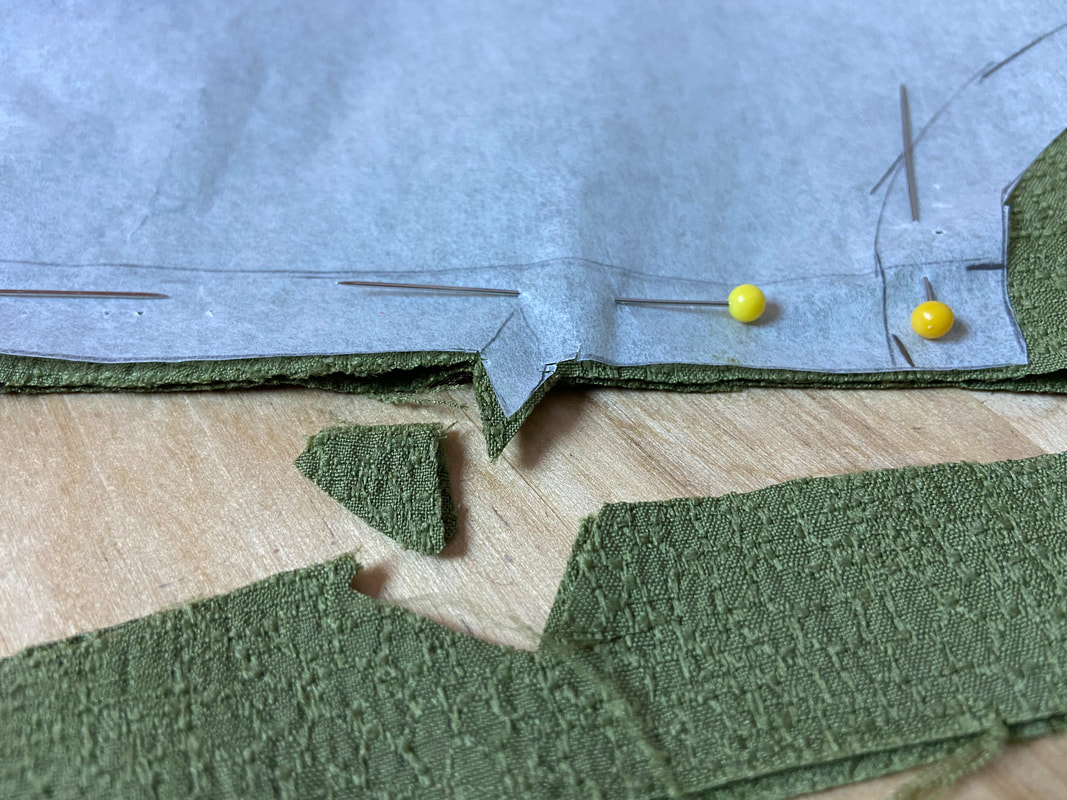To start with, let’s have a little refresher on marking. As you may recall, marking is the process of transferring important notations from patterns to the corresponding fabric pieces. These notations are then used in the sewing process.
The marking process takes place after the sewing patterns have been cut but before they are separated from the fabric pieces. This step is extremely important especially when darts and notches are present.
When it comes to notches, the marking technique you use is based on the type of notches your patterns have. Are the pattern notches triangular in shape? Do the triangles extend outwards or inwards? Perhaps the notches are marked with a simple “T” shape? All of these elements will guide you the process of transferring the notches to fabric.
So what exactly are notches?
Notches are wedge cuts or slashes added to seam allowance to help match corresponding fabric pieces and edges in the sewing process.
Notches are imperative in the sewing process, especially if you are a sewing beginner and not quite familiar with the general shape of the garment pieces.
Most store-bought patterns feature notches that are marked with a connected inward and outward triangle. The two shapes allow you to choose between cutting the notches inward or outward.
If you draft some of your own patterns at home, it may be easiest to use slash notches. These notches are marked with a “T” shape placed horizontally at the desired location on the pattern’s edge.
Which notching style to use and how to mark each one of them is described in detail below.
Marking Inward Triangle Notches
Inward triangle notches require that a triangular shape is cut into the body of the seam allowance. The point of the triangle should be directed inwards and stopping at about halfway through the seam allowance.
To mark an inward triangle notch, carefully slash each notch leg with the tip of your scissors through both paper pattern and fabric layer(s) underneath.
Be very careful not to cut past the notch point.
Once clipped, remove the little triangle cut-out. This will leave you with a triangular indent within the seam allowance.
After all notches are cut, unpin and separate the paper pattern from the fabric piece. When matching corresponding seam, the two triangular cuts should overlap and match perfectly, from the corresponding top to the bottom of the seam.
While inward triangle notches are visible and great for sewing beginners, they do leave an irreversible cut within the garment’s seam allowance. For that reason, you should always consider the type of seam allowance finish needed prior to deciding whether to cut inward our outward notches.
Most seam finishes, especially self-enclosed styles, will not be applied properly if the seam allowance features large triangular cuts. Especially in the case of open garments, like unlined coats and jackets where the seam allowance is visible from the outside of the garment, inward-cut notches will jeopardize the look and structure of the seam.
You should also consider type of fabric. If the fabric is loosely woven and unravels easily, it is best not to cut within the seam allowance as it may further weaken the seam, not to mention making the seam allowance difficult to clean finish. In this instance, outwardly-cut notches (described below) are most suitable.
Marking Outward-Cut Triangle Notches
Outward-cut notches are those that extend away from the seam allowance creating a triangular extension. They are just as visible but much safer to use than inward-cut notches.
On the paper patterns, outward-cut triangle notches look similar to the inward-cut style but instead of the triangular point facing inwards (halfway into the seam allowance), they point outward away from the seam allowance edge.
To transfer an outward triangle notch, it is easiest to first cut around the notch leaving some excess around it. Next, cut the rest of the seam edges on both sides.
To finally transfer the shape of the notch, carefully cut down each notch line from the triangle point in towards the patterns seam allowance edge.
Use the tip of your scissors for precision and don’t cut into the seam allowance.
When the paper pattern is separated from the fabric, the notches will form visible triangular extensions.
Once the corresponding seam edges are matched and sewn, the notches are no longer needed. Conveniently, they can be easily trimmed for a smooth, uninterrupted seam allowance edge.
If you are a sewing beginner and working from patterns that provide you a choice between cutting the notches inward or outward, always choose the outward method. They are much safer, visible (once the patterns are separated from the fabric), and reversible if/when no longer needed.
Marking Slash Notches
Slash notches are a fast notching method used mainly by intermediate-to-advanced dressmakers. Slash notches are used mostly in the clothing manufacturing world as they provide a fast, easy and effective way to transfer notches.
If you are considering drafting your own patterns, slash notches are the simplest and easiest way to denote notches on your patterns. They tend to be more precise than triangle notches and are simple to mark with a “T” placed horizontally on the pattern’s seam allowance edge.
The leg of the “T” represents the cut line, while the top intersecting line marks the stop point for the cut.
A slash notch is cut at about halfway through the seam allowance, or 1/4” in from the seam allowance edge. Since the intersecting “T” line denotes the point where the cut should end, it is always located within the seam allowance as shown below.
Marking a slash notch is very easy. Once the pattern pieces have been cut (but prior to unpinning them form the fabric pieces), slash down the leg of the horizontal T, ending at the intersecting vertical line.
If working with textured, thick fabrics or marking through multiple layers, check that the slash is long enough to leave a visible mark in the seam allowance.
You may need to slash a little past the notch line in order to achieve a clearly marked slit. However, be careful not to get too close to the seamline or you risk weakening the actual seam.
Slash notches are not as visible as triangular notches, thus they are perhaps not the best option for beginners. Depending on the fabric, you may have to sometimes pull the edge apart just to find the slash marks. For that reason, slash notches are more suitable for those that are familiar with the general shape of the front and back pieces comprising a garment, and can easily tell them apart.
Needless to say, slash notches are a great way to quickly mark fabric edges without too much damage to the seam allowance edges. In terms of how much of an irreversible mark they leave, slash notches fall somewhere in between inward and outward triangle notches. While they do leave irreversible cuts into the seam allowance, these cuts are often considered negligible in terms of how they interact with most seam finishing techniques.



















